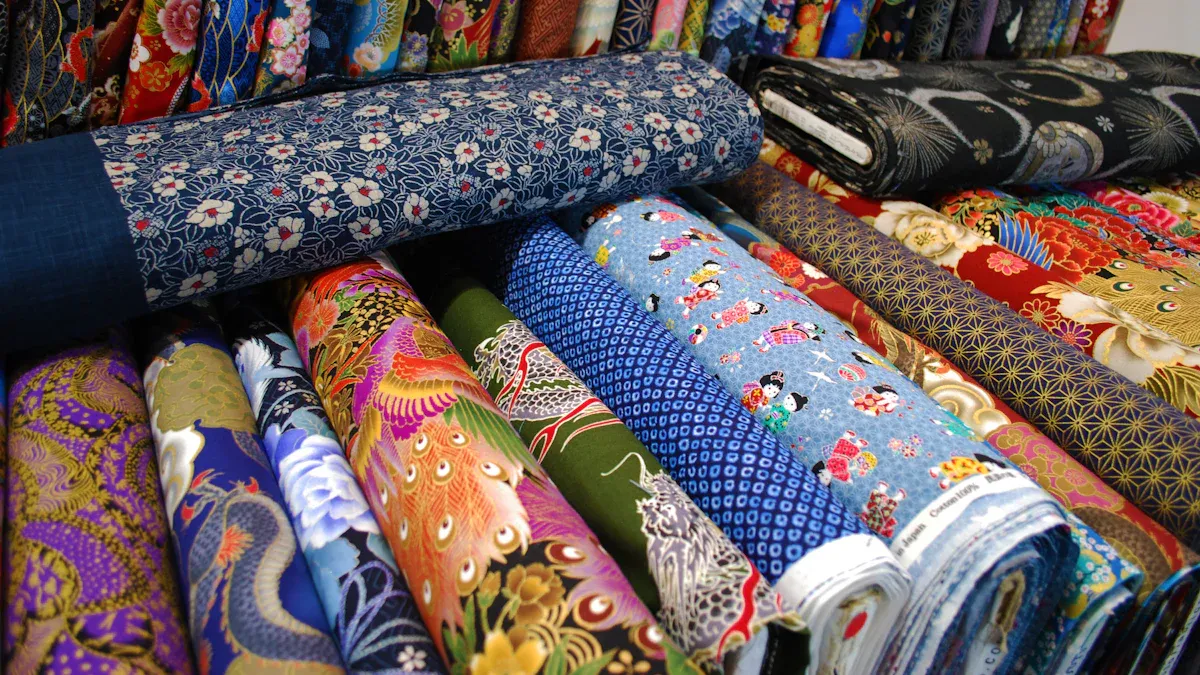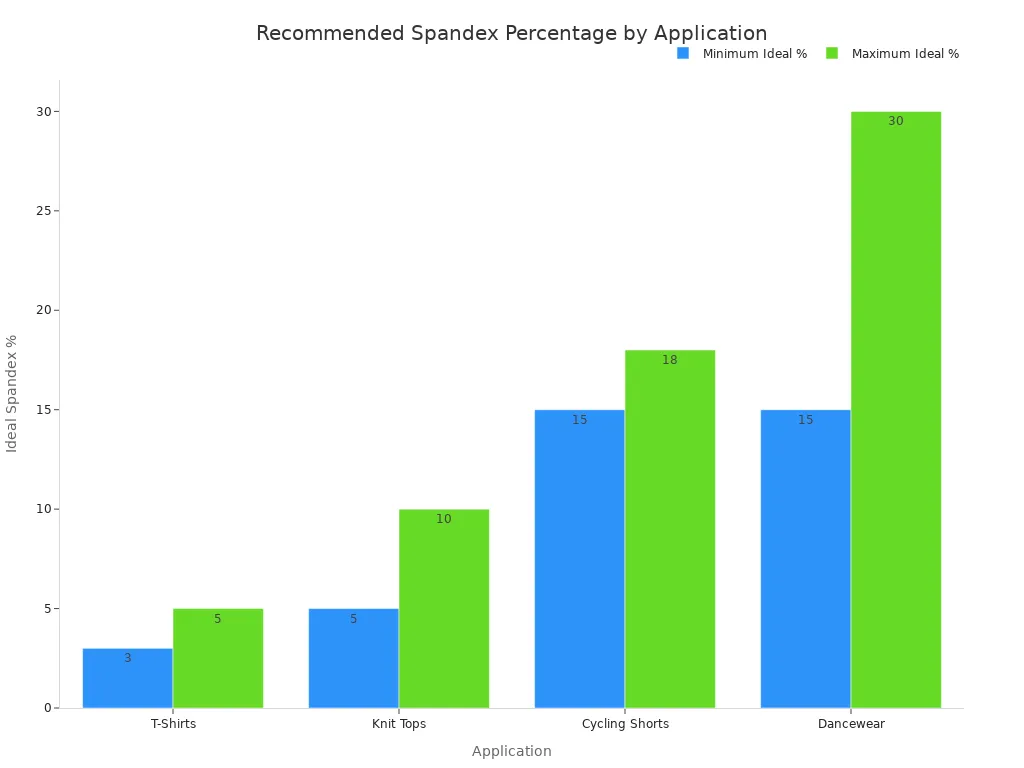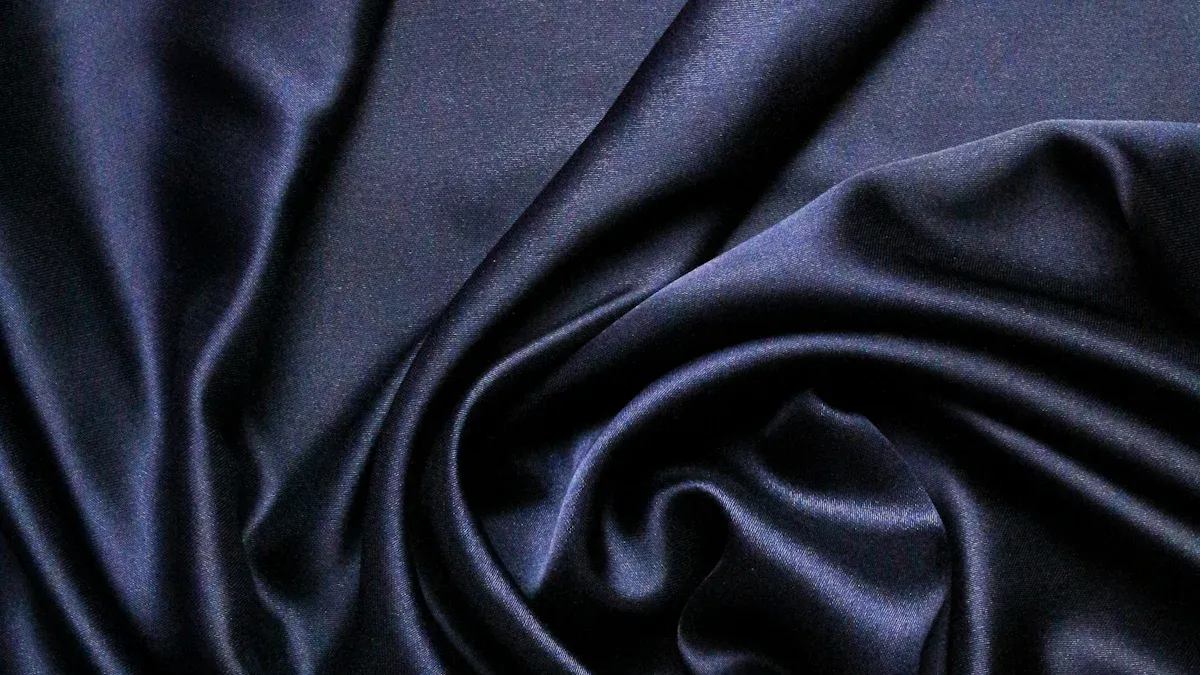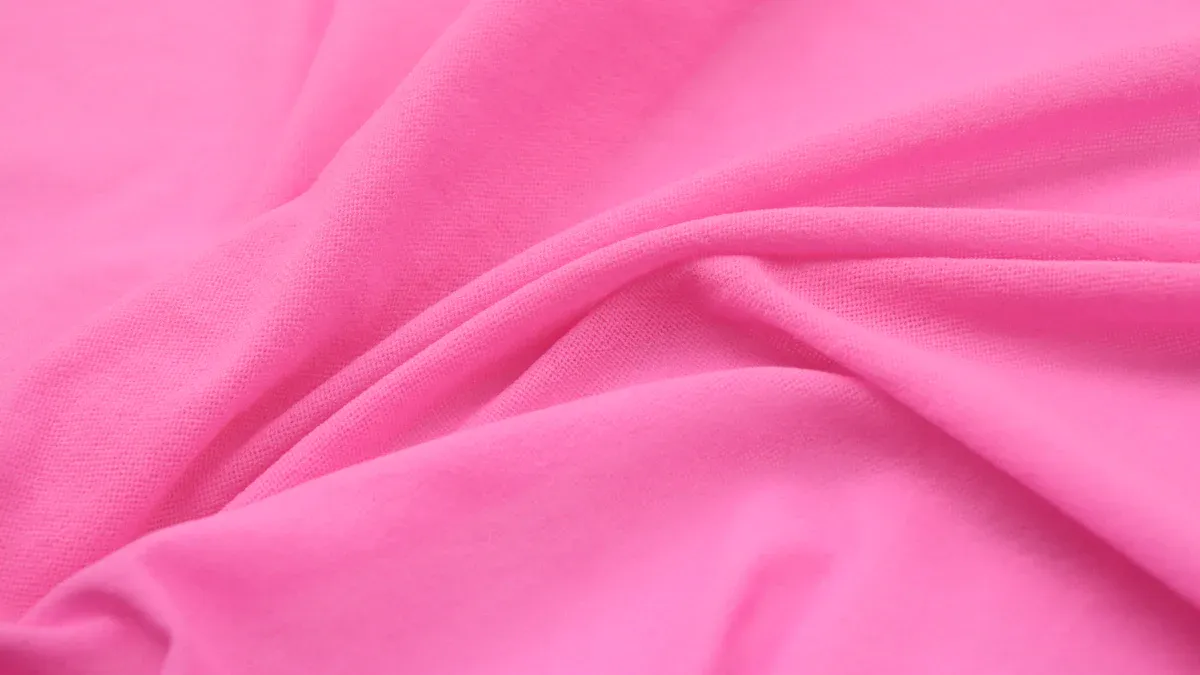
Spandex fabric offers unparalleled stretch and recovery. This quality allows garments to move with the body and snap back into shape. The lightweight and smooth texture of spandex fabric delivers exceptional comfort. It creates a body-hugging fit without any restriction. From high-fashion runways to performance apparel, spandex is a key material in modern design. The growing importance of this spandex fabric is clear. A good spandex fabric roll is the starting point for perfect-fitting clothes.
Market Insight: The Rise of Spandex 📈 The global market for spandex reflects its widespread adoption in the textile industry.
Metric Value Global Spandex Market Value (2024) USD 8.99 Billion Projected Market Value (2032) USD 17.41 Billion Compound Annual Growth Rate (CAGR) (2026-2032) 9.51%
Key Takeaways
- Spandex fabric stretches a lot and returns to its original shape. This makes clothes fit well and feel comfortable.
- Spandex is good for many clothes, from everyday jeans to fancy dresses and sports gear. It adds comfort and style.
- Spandex makes athletic wear better. It helps muscles and speeds up recovery after exercise.
- Choose the right spandex fabric for your project. Look at how much it stretches and its weight to get the best results.
- Care for spandex clothes properly. Wash them in cold water and air-dry them to keep them stretchy and lasting longer.
What Makes Spandex Fabric So Versatile?
The versatility of spandex fabric comes from a unique combination of core properties. These advantages of spandex fabric make it a top choice for many applications. Its chemical structure and physical characteristics give it an edge over other materials. Understanding these features shows why spandex is so popular.
Unmatched Elasticity and Shape Memory
Spandex has incredible elasticity. Its molecular makeup includes a chain-like polyurethane structure. This design allows the spandex fabric to stretch up to five times its original length and snap back into shape. The material contains both soft, stretchy segments and rigid segments. This combination provides both strength and flexibility. When stretched, the long polymer chains inside the fabric align and extend. When released, they retract, pulling the spandex fabric back to its original form.
Stretch Comparison: Spandex vs. Other Materials The stretch and recovery of spandex far exceed that of materials like rubber. This superior performance ensures a lasting, perfect fit.
Material Typical Stretch Recovery Spandex / Elastane Very High (600%) Excellent Lycra Very High (600%) Superior Natural Rubber High Poor to Good
Superior Comfort and Freedom of Movement
Spandex fabric offers superior comfort. It provides flexibility and freedom of movement without restriction. This makes it ideal for clothing where people need to move easily. The fabric’s impressive stretch and flexibility adapt to every body movement. When blended with other fibers like polyester, spandex enhances comfort and breathability. Polyester fibers are excellent at wicking moisture away from the skin. This keeps the wearer cool and dry. The spandex in the blend adds the necessary stretch and flexibility for a snug, comfortable fit.
Durability and Resistance to Wear
Durability is another key feature of spandex. The fabric shows strong resistance to everyday substances.
- It resists damage from body oils and sweat.
- Lotions and sunscreens do not easily degrade the material.
This resistance helps garments maintain their quality over time. High-performance spandex blends also have excellent abrasion resistance. This durability and stretch mean the fabric can withstand rubbing without pilling or tearing quickly. High-quality spandex fabric often scores over 30,000 cycles on the Martindale abrasion test, proving its strength for long-term use.
Elevating Fashion with Spandex
Spandex fabric has revolutionized the fashion industry. It blends function with style, offering designers new creative possibilities. The material’s unique properties allow for garments that are both beautiful and comfortable. This versatility in design makes spandex a staple in modern fashion, from casual basics to elegant evening wear.
Everyday Comfort in Jeans and Tees
Spandex brings exceptional comfort to everyday apparel. A small amount of this elastic fiber can completely transform the fit and feel of common clothing items like jeans and t-shirts. This addition is a key reason why modern fabric for apparel feels so good to wear.
In denim, the percentage of spandex determines the stretch and feel. Consumers have different preferences, but the goal is always a better fit.
- 1-2% Spandex: This blend offers a hint of stretch. It provides enough flexibility for comfort during movement without feeling overly elastic. Many prefer this for a classic denim feel that still allows for easy bending and sitting.
- 3-4% Spandex: Jeans with this higher percentage offer significant stretch. They hug the body’s curves and provide maximum comfort. These jeans are less likely to bag at the knees because the spandex fabric helps them snap back into shape.
T-shirts also benefit from spandex blends. The fabric helps the tee maintain its shape after many washes. It prevents the collar from stretching out and keeps the overall fit consistent. This makes the apparel perfect for layering. A well-fitting tee is an ideal base, and spandex ensures it stays smooth under sweaters or jackets, making layering made easy.
Sleek Silhouettes in Formal Wear
Spandex is a secret weapon in high-fashion formal wear. Designers use spandex fabric to create stunning gowns that offer a sleek, body-hugging silhouette without sacrificing comfort. This allows for elegant apparel that moves with the wearer. Special blends like stretch Mikado or contour fabrics provide structure and support while remaining flexible.
These materials enable designers to craft breathtaking pieces for formal occasions. Examples of this fashion trend include:
- Elegant mermaid gowns made from sequin-covered stretch velvet.
- Sleek one-shoulder bodycon dresses with dramatic capes.
- Luxe velvet gowns with shirred waistbands for a flattering shape.
- Off-the-shoulder maxi dresses that hug curves perfectly.
Elegance Meets Comfort 💃 Spandex evening dresses give wearers a polished look with total freedom of movement. The fabric gently hugs curves and provides support, making it suitable for many body types. These gowns are a smart and stylish choice for any formal event.
The Foundation of Swimwear and Lingerie
Spandex is the cornerstone of swimwear and intimate apparel. Its properties are perfectly suited for garments that need to fit like a second skin. For competitive swimwear, spandex is non-negotiable. Its performance characteristics ensure a winning fit. Key properties include:
- Exceptional stretch that molds to the body.
- Excellent shape retention after repeated use.
- The ability to create secure, compressive fits.
In lingerie and shapewear, spandex technology has enabled major innovations. It is the foundation for modern layering. The evolution of spandex fabric allows for seamless construction, creating smooth, invisible lines under clothing. This technology makes layering made easy and comfortable. Advanced spandex blends also offer targeted support and breathability, enhancing both the function and feel of intimate apparel. This versatility gives designers endless aesthetic options, from delicate lace overlays on a stretch base to bold, colorful prints, proving that fashion and function can coexist beautifully.
Powering Performance: Spandex in Functional Gear

Spandex fabric is a cornerstone of high-performance functional gear. Its unique properties provide athletes and individuals with the support they need to excel. This material powers a wide range of performance apparel, from professional sportswear to medical supports. The elasticity and durability of spandex make it an essential component for functional clothing.
Enhancing Athletic Performance
Spandex fabric is vital in sportswear designed to boost athletic output. The material’s exceptional flexibility allows for a full range of motion. This is critical in sports that demand agility and precision. Athletes in various disciplines rely on spandex for a competitive edge.
- Cycling: Compression shorts with spandex reduce muscle fatigue and improve endurance.
- Swimming: Tight-fitting suits made from spandex fabric reduce drag in the water.
- Track and Field: Compression apparel helps minimize muscle vibrations, allowing athletes to maintain form.
- Gymnastics: The material provides support and enhances body awareness for precise movements.
The right spandex fabric blend offers more than just a great fit. It often includes moisture-wicking properties to pull sweat away from the skin. This feature, combined with quick drying capabilities, keeps athletes comfortable. Many performance fabrics also offer excellent breathability for enhanced comfort during intense activity. While some studies show mixed results on direct performance enhancement, the benefits for recovery and perceived comfort are clear. The use of spandex is unlikely to negatively affect performance and may offer improvements in specific situations.
Performance and Perception 🏃♀️ Research shows that while spandex compression gear may not always increase speed or power, it often reduces an athlete’s perception of muscle soreness after exercise. For example, one study found that cricket players reported less muscle soreness after sprinting and throwing when wearing compression clothing. This psychological and physical comfort can be a significant advantage.
Compression for Support and Recovery
Compression garments are a key tool for athletic recovery. Spandex is the primary fiber that gives these items their supportive squeeze. This pressure helps stabilize muscles during and after a workout. The stretch and flexibility of the spandex fabric allow for a snug yet non-restrictive fit.
Graduated compression is a specific technology used in recovery apparel. These garments apply more pressure at the extremities, like the ankles, and less pressure closer to the body’s core. This design helps improve blood circulation.
- It pushes out lactic acid from the muscles.
- It increases oxygen delivery to muscle tissues.
- It speeds up the muscle repair process.
Studies confirm that wearing compression garments can aid recovery. One study on healthy male students showed that wearing compression gear after intense exercise significantly reduced delayed onset muscle soreness (DOMS). The participants also recovered their muscle strength faster. The spandex in these garments helps reduce muscle oscillation, easing mechanical stress on the tissues and promoting a quicker return to peak performance. The fabric’s moisture-wicking properties and quick drying nature also add to post-workout comfort.
Medical and Orthopedic Applications
The benefits of spandex extend into the medical field. Its unique elasticity makes it ideal for orthopedic braces and medical compression wear. Medical-grade spandex fabric provides consistent, reliable support for injuries and chronic conditions. This material offers both flexibility and strength, which are crucial for effective treatment and patient comfort.
Designers use spandex to create a variety of medical products. These items help patients manage conditions and recover from injuries.
| Medical Product | Primary Function |
|---|---|
| Elastic Bandages | Provide support for sprains and strains. |
| Orthopedic Braces | Stabilize joints like the knee, wrist, or ankle. |
| Hernia Support Garments | Offer targeted compression and support. |
| Gynecomastia Vests | Provide compression with breathability. |
These products rely on high-quality spandex fabric to deliver targeted pressure without sacrificing mobility. The material’s moisture-wicking properties and breathability are also important for long-term wear, preventing skin irritation. This makes spandex an indispensable material in modern medical and orthopedic solutions.
How to Choose the Perfect Spandex Fabric Roll

Choosing the right spandex fabric roll is the first step toward a successful project. The material’s properties directly impact the final garment’s fit, feel, and performance. A careful selection ensures the finished item meets all expectations for comfort and function. Understanding the details of the spandex fabric is key.
Understanding Fabric Blends and Weight (GSM)
The type of fiber blended with spandex greatly affects the fabric’s characteristics. Polyester and nylon are common partners for spandex. Each blend offers distinct advantages. A polyester-spandex fabric provides a firmer feel and is very durable. A nylon-spandex fabric is known for its soft, silky texture. The right choice depends on the project’s needs.
| Feature | Polyester-Spandex | Nylon-Spandex |
|---|---|---|
| Feel | Firmer, matte finish | Softer, smoother, silky |
| Durability | Highly durable, colorfast | Strong but can fade with sun exposure |
| Moisture-Wicking | Good moisture-wicking | Dries faster than polyester |
| Cost | More budget-friendly | Higher cost for a premium feel |
Fabric weight, measured in Grams per Square Meter (GSM), also plays a crucial role. A higher GSM indicates a denser, more opaque fabric. For example, a quality cotton spandex jersey fabric for yoga leggings might have a GSM of 180-220. Swimwear requires a heavier spandex fabric, typically 250-320 GSM, for better coverage and support. A lighter cotton spandex jersey fabric is great for t-shirts.
Decoding 2-Way vs. 4-Way Stretch
The term “stretch” describes how a fabric moves. Spandex fabric comes in two main types: 2-way and 4-way stretch. The difference lies in their construction and direction of elasticity.
- 2-Way Stretch: This fabric stretches in one direction, usually from side to side (selvage to selvage). It offers comfort for everyday clothing.
- 4-Way Stretch: This fabric stretches in four directions: lengthwise, widthwise, and diagonally. It provides maximum freedom of movement.
The inclusion of spandex fibers gives the material its ability to stretch and recover. Four-way stretch is essential for tight-fitting garments like swimwear. This quality ensures the spandex fabric moves with the body without restriction.
Matching the Fabric to Your Project
Selecting the correct spandex fabric ensures the best outcome. The project’s end-use determines the ideal blend, weight, and stretch. For everyday items like t-shirts or casual pants, a small percentage of spandex (3-10%) provides comfort and shape retention. A cotton spandex jersey fabric is a popular choice for these items.
High-performance apparel requires a higher spandex content. Garments like cycling shorts or dancewear need significant stretch for a full range of motion. A custom fabric for designers often involves finding the perfect balance for a specific vision. Choosing the right spandex fabric roll is critical. A quality cotton spandex jersey fabric can be very versatile.

For example, a cotton spandex jersey fabric with 5% spandex is great for a knit top. A cotton spandex jersey fabric with 15% spandex is better for activewear. The right cotton spandex jersey fabric makes all the difference.
Working With Your Spandex Fabric
Working with spandex fabric opens up a world of creative possibilities. The material’s unique stretch requires specific techniques for a professional finish. Before starting a project, it is wise to test settings on a scrap piece of cotton spandex jersey fabric. This simple step helps prevent mistakes on the final piece. Using pattern weights instead of pins can also prevent holes in the delicate spandex fabric.
Essential Sewing Tips and Techniques
Sewers should not stretch the spandex fabric as it goes through the machine. They should guide it gently to maintain its shape. A walking foot can be a helpful tool. It feeds the top and bottom layers of the cotton spandex jersey fabric evenly. This prevents the material from waving or puckering. Taking time and using the right tools ensures a high-quality result when sewing with spandex. A good cotton spandex jersey fabric deserves careful handling.
Needles and Stitches for Stretch Fabrics
Choosing the correct needle and stitch is critical for success with spandex. The right combination prevents skipped stitches and broken seams.
- Needles: A stretch needle is best for very stretchy materials like a cotton spandex jersey fabric. A jersey or ballpoint needle also works well for many knits. Testing both types on a scrap of cotton spandex jersey fabric can show which performs better with a specific machine.
- Stitches: A zigzag stitch is a common choice that provides necessary stretch. For stronger seams on tight apparel, a triple straight stitch is an excellent option. The lightning bolt stitch also creates a very stretchy seam and helps reduce puckering on the spandex fabric.
Proper Care for Spandex Garments
Proper care maintains the elasticity and durability of spandex garments. Following washing and drying best practices extends the life of the clothing. The durability of the spandex depends on gentle handling.
Washing and Drying Tips 🧼
- Wash with care. Use cold water and a gentle cycle. Place delicate items in a mesh bag. Never use fabric softener or chlorine bleach on spandex.
- Air-dry when possible. Lay the item flat or hang it away from direct sunlight. Heat from a dryer damages the elastic fibers.
- Use low heat if necessary. If using a machine, choose the lowest heat or air-dry setting. Remove the cotton spandex jersey fabric item while it is still slightly damp.
A spandex fabric roll is the starting point for creating items that blend style, comfort, and performance. The material’s unique stretch and recovery make it essential in modern textiles. Innovations now provide sustainable quality options, including recycled and plant-based fibers. Selecting the correct spandex fabric roll is crucial for a high-quality outcome. This focus on quality ensures a perfect-fitting result for any fashion or functional gear project.
FAQ
What is the difference between Spandex, Lycra, and Elastane?
Spandex and elastane are generic names for the same synthetic fiber. They describe the material’s chemical makeup. Lycra is simply a well-known brand name for a specific type of spandex fiber. All three terms refer to the same highly elastic material.
Can I use a regular sewing machine for spandex fabric?
Yes, a regular sewing machine works for spandex. Sewers should use a special needle, like a ballpoint or stretch needle. A zigzag or lightning bolt stitch provides the necessary stretch. These simple adjustments prevent skipped stitches and ensure durable seams.
Why is GSM important when choosing spandex?
GSM (Grams per Square Meter) indicates fabric weight and density. A higher GSM means a thicker, more opaque fabric, ideal for swimwear or leggings. A lower GSM is suitable for lighter items like t-shirts. Choosing the right GSM ensures proper coverage and performance.
Pro Tip 💡 For high-performance activewear, a GSM of 180-220 is a great starting point. For swimwear, look for a GSM of 250 or higher.
How do I prevent spandex from losing its stretch?
Proper care preserves the fabric’s elasticity. People should wash spandex garments in cold water on a gentle cycle. It is best to air-dry them away from direct heat or sunlight. High heat from a dryer can damage the elastic fibers and ruin the fit.



